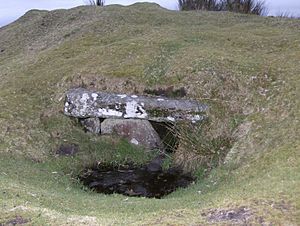Rillaton Barrow facts for kids
Rillaton Barrow (which means "Rillaton Mound" in Cornish) is an ancient burial mound from the Bronze Age. It is located in Cornwall, UK, on the eastern side of Bodmin Moor. The site is about 6 kilometers (4 miles) north of Liskeard, near the village of Linkinhorne.
In 1837, archaeologists dug up Rillaton Barrow. They found a burial right in the middle of the mound, which was about 25 meters (82 feet) wide. The person was buried in a stone box called a cist, which was about 2 meters (6.5 feet) long and 1 meter (3.3 feet) wide. Along with the human remains, they found special items called grave goods. These included the famous Rillaton Gold Cup, a bronze dagger, beads, pottery, and other interesting objects.
Contents
The Amazing Rillaton Gold Cup
Quick facts for kids Rillaton Gold Cup |
|
|---|---|
 |
|
| Material | Gold |
| Created | Early Bronze Age, perhaps c. 1700 BC |
| Discovered | Rillaton, Cornwall |
| Present location | British Museum |
The most exciting discovery was the Rillaton Gold Cup. It's a gold cup, about 90 millimeters (3.5 inches) tall, with a handle attached by small metal pins. The cup looks a bit like pottery from the late Neolithic period (around 2300 BC).
For a long time, experts thought the cup was made later, between 1650 and 1400 BC. But in 2001, another similar cup, the Ringlemere Cup, was found. This new discovery helped experts rethink the age of the Rillaton Cup. Now, they believe it was made around 1700 BC.
Is the Rillaton Cup from Far Away?
Some people thought the Rillaton Gold Cup looked like cups from ancient Greece, especially from a place called Mycenae. This made them wonder if people in Cornwall traded or had connections with cultures far away in the Mediterranean Sea. The Pelynt Dagger, also found in Cornwall, was another item that made people think this.
However, in 2006, a study by Stuart Needham and other experts suggested that the cup probably wasn't from so far away. They found other similar "unstable" cups (cups that couldn't stand up on their own) made of valuable materials in northwestern Europe. They believe the Rillaton Cup fits in with these local finds. While the Rillaton Cup might have been made around 1700 BC, it could have been buried much later. Interestingly, the Pelynt Dagger might actually be from Mycenae!
The Cup's Royal Journey
After the Rillaton Gold Cup and other items were found in 1837, they were sent to King William IV as "Duchy Treasure trove." This meant they belonged to the royal family.
There's a fun story that one of the kings, either King George IV or William IV, used the cup to hold his cufflinks! Another story says that after being lost for many years, the cup was found being used by King George V to store his collar studs!
After King George V passed away in 1936, people realized how important the cup and the dagger were. They were then loaned to the British Museum, where the Rillaton Gold Cup is still on display next to the similar Ringlemere Cup. Even though it's in the museum, it still belongs to the Royal Collection. Sadly, the other items found with the cup have disappeared, and we don't have good descriptions or pictures of them. If we did, they might help us figure out the exact date the cup was buried. You can see a copy of the cup at the Royal Cornwall Museum in Truro.
The Legend of the Cup
There's a local legend about Rillaton Barrow. People say it's haunted by the ghost of an ancient druid priest. The legend says this ghost offers travelers a drink from a cup that can never be emptied. One night, a traveler supposedly threw the cup's contents at the ghost. The next day, that traveler was found dead in a nearby ravine.


